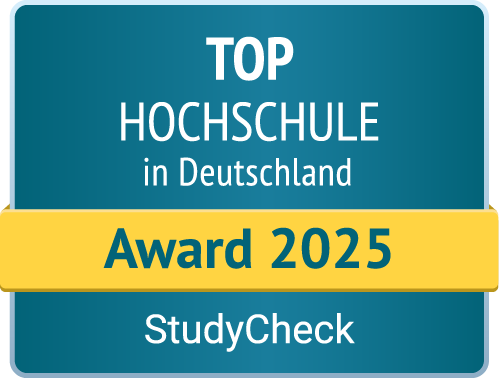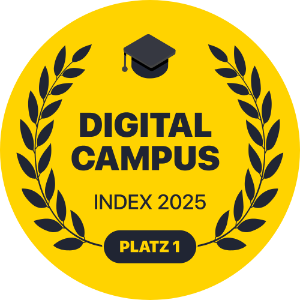- Bachelor
- Applied Polymer Technology
- Applied Business and Media Psychology
- Business administration
- Biomedical Engineering
- Data Protection and IT Security
- Industrial Biotechnology
- Intercultural Management
- International Management (top athletes)
- Artificial Intelligence and Cognitive Systems
- Multimedia and Communication
- Sustainable Engineering
- Master
- Applied Artificial Intelligence and Digital Transformation
- Applied Biotechnology
- Applied Research in Engineering Sciences
- Data Governance and Ethics
- Digital Learning
- Digital Marketing
- Energy Management and Energy Technology
- Innovation and Entrepreneurship
- International Product and Service Management
- Creative Management
- Further education
- Research
- University
- Service
- Jobs
- Prodekan der Fakultät Medien
- Studiengangsleiter Visualisierung und Interaktion in digitalen Medien (VIS)
- Professor Multimedia und Kommunikation (MUK)
- Vorsitzender Prüfungskommission Visualisierung und Interaktion in digitalen Medien (VIS)
- Stellvertretender Vorsitzender Prüfungskommission Multimedia und Kommunikation (MUK)
- Leiter 3D-Labor
- Mitglied Fakultätsrat Medien
- Grafische Gestaltung
- 3D Visualisierung
- 2D/3D Animation
- CGI und Compositing
- 3D-Virtual Reality
- Corporate Design
- Motion-Capture
- Mitarbeiterin Bereich Studierendenservice
- Ressortjournalismus
- Visualisierung und Interaktion in digitalen Medien
- Studiengangsassistentin
- Visualisierung und Interaktion in digitalen Medien (VIS)
- Professor Multimedia und Kommunikation (MUK)
- Professor Digital Learning (DL)
- Professor Ressortjournalismus (RJO)
- Professor Visualisierung und Interaktion in digitalen Medien (VIS)
- Mitglied Fakultätsrat Medien
- Mitglied Senat und Hochschulrat
- Bewegtbild/Kamera
- Professorin Visualisierung und Interaktion in digitalen Medien (VIS)
- Stellvertretende Frauenbeauftragte Fakultät Medien
- Mitglied Senat und Hochschulrat
- Mitglied Fakultätsrat Medien
- Grafische Visualisierung
- Motion Design / Motion Graphics
- Media Space
- Visual Music
- Animation
- Ortsspezifische Medieninstallation
- Professor Multimedia und Kommunikation (MUK)
- Professor Visualisierung und Interaktion in digitalen Medien (VIS)
- Praktikumsbeauftragter Visualisierung und Interaktion in digitalen Medien (VIS)
Gestaltung interaktiver Medien
- Professor Visualisierung und Interaktion in digitalen Medien (VIS)
- 2D / 3D Content Produktion in interaktiven Anwendungen
- Interaktive Illustration & Comic
- Game Design
- Game Art
- Game Development
- World Building
- Laboringenieur Visualisierung und Interaktion in digitalen Medien (VIS)
Faculty of Media
Visualization and Interaction in
Digital Media (VIS)Study overview
The course, Visualisation and Interaction in Digital Media, offers a practical and scientific education in the media field.
Developments in all scientific research areas, in industry, the economy and society are becoming ever more complex and therefore increasingly difficult to communicate. Graphic and interactive visualisation can supply the tools to convey complex topics and interrelationships in a simple and comprehensible way. This capability fulfils an important key function between developers and scientists, but also in general knowledge transfer.
State-of-the-art laboratories are available to students for learning and for projects. The Faculty of Media also has a pool of mobile equipment for external productions.
The trade magazine Digital Production reported on the Visualisation and Interaction in Digital Media degree programme in its May/June 2021 issue.
You can download the article as a PDF here.
Short form VIS Type of study Full time Standard period of study 7 semesters Award Bachelor of Arts (B.A.) Start of studies Winter semester Admission restrictions None Lecture location Ansbach Language of instruction German Course management Prof. Christian Barta Student advisory service Prof. Christian Barta Internship Officer VIS Prof. Florian Machill Student Services studierendenservice.vis(at)hs-ansbach.de Study structure
The programme is strongly project-based and following the foundation course in the first two semesters, there is an opportunity to specialise early in the 3rd and 4th semesters. After the practical semester in the 5th semester, further specialisation is possible through projects in the 6th and 7th semesters, the bachelor thesis in the 7th semester concludes the programme.
Foundation Semesters 1 and 2
A prerequisite for the course is a keen interest in and engagement with the possibilities of digital media and computer graphics. Building on this, the foundation training in the first two semesters imparts basic knowledge in areas relevant to the conception and creation of visualisation projects.
Specialization Semester 3 and 4
The subject specialisation takes place through the independent selection of modules from six specialisation areas. Four modules from at least two specialisation areas must be taken per semester, so students can decide for themselves which focus they want to place in the visualisation area: Classic 3D visualisation, the development of interactive applications for screen and XR or web and app projects. The specialisation modules offered are constantly adapted and updated to the rapid development in these areas. Examples are Motion Graphics, Compositing, Virtual Characters, Interactive 3D or Web Development. In addition, three elective modules can be taken to respond to current trends or offers. The compulsory module Project Management provides the important competences for the successful implementation of media projects.
Practice, project phase and completion of semester 5 - 7
Practical experience in the fifth semester:
In the 5th semester the focus is on the contact with practice. This is indispensable in the rapidly developing media professions. The 5th semester allows students to use what they have learnt in four semesters in a meaningful way in their practical internships and enables them to establish practical contacts for the subsequent project semesters. The provision of suitable internships is supported by close contacts with companies and by an internship exchange.
Project phase and completion:
In the project phase of the 6th semester, self-chosen projects or projects with external partners can be carried out. However, there is also the possibility to continue projects that have been carried out during the internship semester. The project is accompanied by a project management review. In addition, in the 6th semester entrepreneurial and operational competence is taught through the modules Media Law and Business. The 6th semester is also suitable as a semester abroad.
The project in the 7th semester can be a continuation of the theoretical written bachelor's thesis or it can be an independent project.Examples of projects
The following examples show the variety of possible projects:
Persons

Prof. Christian Barta
Studiengangsleiter Visualisierung und Interaktion in digitalen Medien (VIS) / Vorsitzender Prüfungskommission Visualisierung und Interaktion in digitalen Medien (VIS)
0981 4877-360 92.2.4 nach Vereinbarung christian.barta vCard
Prof. Christian Barta

Studiengangsleiter Visualisierung und Interaktion in digitalen Medien (VIS) / Vorsitzender Prüfungskommission Visualisierung und Interaktion in digitalen Medien (VIS)
Funktionen:
Lehrgebiete:
Forschungsfelder:

Sophia Merz
Mitarbeiterin Bereich Studierendenservice
0981 4877-576 54.1.12 nach Vereinbarung studierendenservice.vis vCard
Sophia Merz

Mitarbeiterin Bereich Studierendenservice
Funktionen:
Betreute Studiengänge:

Corinna Stern
Studiengangsassistentin Visualisierung und Interaktion in digitalen Medien (VIS)
Corinna Stern

Studiengangsassistentin Visualisierung und Interaktion in digitalen Medien (VIS)
Funktionen:
Betreute Studiengänge:

Prof. Michael Leuthner
Professor Visualisierung und Interaktion in digitalen Medien (VIS)
0171 3849664 50.4.5. Dienstags 10:00–11:30 Uhr michael.leuthner vCard
Prof. Michael Leuthner

Professor Visualisierung und Interaktion in digitalen Medien (VIS)
Funktionen:
Lehrgebiete:

Prof. Verena Kraemer
Professorin Visualisierung und Interaktion in digitalen Medien (VIS)
Prof. Verena Kraemer

Professorin Visualisierung und Interaktion in digitalen Medien (VIS)
Funktionen
Lehrgebiete
Forschungsfelder
Vita
Studium
1989–90 Studium Architektur, École Nationale Supérieure d’Architecture de Paris La Villette, Paris (F)
1990–91 Studium Design, Atelier de Sèvres, Paris (F)
1994 Studium Grafik-Design, St. Petersburg Stieglitz State Academy of Art and Industry (RUS)
1991–97 Diplomstudium Kommunikationsdesign, Schwerpunkt Audiovisuelle Medien, Technische Hochschule Nürnberg Georg Simon Ohm
Beruf1997-2014 Selbständige Designerin in verschiedenen Kommunikations- und Designagenturen in München und Nürnberg für Endkunden wie adidas, Siemens, BMW, Audi, Mini, ProSiebenSat.1 Media SE (Auswahl). Entwicklung von Gestaltungskonzepten und deren visuelle Umsetzung bis zum Endprodukt. Leitung des Design-Teams, Kundenkontakt sowie Projektkoordination in den Bereichen Printdesign, Webdesign und im Schwerpunkt Motion Design.
Lehre2002–2015 Lehraufträge für Motion Graphics und Visual Effects an der TH Nürnberg und der macromedia Hochschule München
2014–2021 Professur und Studiengangleitung Film + Motion Design, University of Europe for Applied Sciences, Hamburg
Seit 2021 Professur für grafische Visualisierung in Bild und Bewegtbild an der Hochschule Ansbach

Prof. Florian Machill
Professor Visualisierung und Interaktion in digitalen Medien (VIS) / Praktikumsbeauftragter Visualisierung und Interaktion in digitalen Medien (VIS)
0981 4877-314 50.4.2 nach Vereinbarung florian.machill vCard
Prof. Florian Machill

Professor Visualisierung und Interaktion in digitalen Medien (VIS) / Praktikumsbeauftragter Visualisierung und Interaktion in digitalen Medien (VIS)
Funktionen:
Lehrgebiete:

Prof. Sebastian Stamm
Professor Visualisierung und Interaktion in digitalen Medien (VIS)
0981 4877-382 50.4.2 nach Vereinbarung sebastian.stamm vCard
Prof. Sebastian Stamm

Professor Visualisierung und Interaktion in digitalen Medien (VIS)
Funktion:
Lehrgebiete:

Johannes Schweigert
Laboringenieur Visualisierung und Interaktion in digitalen Medien (VIS)
0981 4877-328 92.2.10 nach Vereinbarung johannes.schweigert vCard
Johannes Schweigert

Laboringenieur Visualisierung und Interaktion in digitalen Medien (VIS)
Funktionen:
© 2025 Hochschule Ansbach






